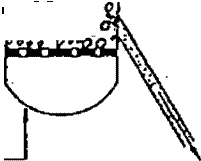 Fluidized bed gasifier
Fluidized bed gasifier
The operation of both up and downdraught gasifiers is influenced by the morphological, physical and chemical properties of the fuel. Problems commonly encountered are: lack of bunkerflow, slagging and extreme pressure drop over the gasifier
A design approach aiming at the removal of the above difficulties is the fluidized bed gasifier illustrated schematically in Fig. 2.10.
Air is blown through a bed of solid particles at a sufficient velocity to keep these in a state of suspension. The bed is originally externally heated and the feedstock is introduced as soon as a sufficiently high temperature is reached. The fuel particles are introduced at the bottom of the reactor, very quickly mixed with the bed material and almost instantaneously heated up to the bed temperature. As a result of this treatment the fuel is pyrolysed very fast,
resulting in a component mix with a relatively large amount of gaseous materials. Further gasification and tar-conversion reactions occur in the gas phase. Most systems are equipped with an internal cyclone in order to minimize char blow-out as much as possible. Ash particles are also carried over the top of the reactor and have to be removed from the gas stream if the gas is used in engine applications.
 |
 |
FUEL
 •• /,«. »/e:.
•• /,«. »/e:.
P,*0o gr(£
pe»;,v’•«?
 |
 |
|
‘O.’f
The major advantages of fluidized bed gasifiers, as reported by Van der Aarsen (44) and others, stem from their feedstock flexibility resulting from easy control of temperature, which can be kept below the melting or fusion point of the ash (rice husks), and their ability to deal with fluffy and fine grained materials (sawdust etc.) without the need of pre-processing. Problems with feeding, instability of the bed and fly-ash sintering in the gas channels can occur with some biomass fuels.
Other drawbacks of the fluidized bed gasifier lie in the rather high tar content of the product gas (up to 500 mg/m3 gas), the incomplete carbon burn-out, and poor response to load changes.
Particularly because of the control equipment needed to cater for the latter difficulty, very small fluidized bed gasifiers are not foreseen and the application range must be tentatively set at above 500 kW (shaft power).
Fluidized bed gasifiers are currently available on a semi-commercial basis from several manufacturers in Europe and U. S.A.
2.3.5 Other types of gasifiers
A number of other biomass gasifier systems (double fired, entrained bed, molten bath), which are partly spin-offs from coal gasification technology, are currently under development. In some cases these systems incorporate unnecessary refinements and complications, in others both the size and sophistication of the equipment make near term application in developing countries unlikely. For these reasons they are omitted from this account.